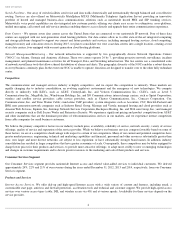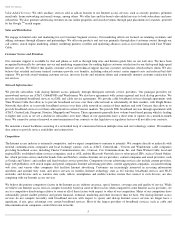Earthlink 2014 Annual Report Download - page 19
Download and view the complete annual report
Please find page 19 of the 2014 Earthlink annual report below. You can navigate through the pages in the report by either clicking on the pages listed below, or by using the keyword search tool below to find specific information within the annual report.
Table of Contents
Item 1A. Risk Factors.
The following risk factors and other information included in this Annual Report on Form 10-
K should be carefully considered. The risks and
uncertainties described below are not the only ones we face. Additional risks and uncertainties not presently known to us or that we currently
deem immaterial also may adversely impact our business operations. If any of the following risks occur, our business, financial condition,
operating results and cash flows could be materially adversely affected.
Risks Related to Our Strategy
We may not be able to execute our strategy to successfully transition to a leading managed network, security and cloud services provider,
which could adversely affect our results of operations and cash flows.
During 2014, we conducted a thorough review of our strategy and implemented a new strategy for growth. Our strategy is to be a leading
managed network, security and cloud services provider for multi-
location retail and service businesses. There can be no assurance that our
strategy will be successful. The market for managed network, security and cloud services is still relatively new and continues to evolve. In
addition, we are decreasing investments in our traditional voice and data products for small business customers, which makes us more reliant on
the managed network services market and on increasing sales to larger multi-
location businesses. If we do not have sufficient customer demand
to support our new services, our financial results may be harmed. Our success depends on the timing and market acceptance of our new products
and services, our ability to market our services in a cost-
effective manner to new customers, our ability to differentiate our services from those of
our competitors, our ability to maintain and expand our sales to existing customers, our ability to strengthen awareness of our brand, our ability
to hire and train effective personnel, our ability to provide quality implementation and customer support for these products and the reliability and
quality of our services. If the market for these services fails to grow or continues to grow more slowly than we currently anticipate, or if our
services fail to achieve widespread customer acceptance, our business would suffer. Any of the foregoing could adversely affect our results of
operations and cash flows.
We may not be able to grow revenues from our growth products and services to offset declining revenues from our traditional products and
services, which could adversely affect our results of operations and cash flows.
Revenues from our traditional products and services, which include voice and data services for small business customers and Internet access
services for residential customers, have been declining due to competitive, technological and regulatory developments and we expect these
revenues to continue to decline. In addition, we are narrowing our product portfolio to provide a more focused suite of services and decreasing
our investments in non-
strategic products, which will also cause revenues to decline. To offset our revenue declines, we are focused on growing
revenues from our growth products and services, which are MultiProtocol Label Switching ("MPLS"), hosted voice and managed network
services. We may not be successful in our efforts to increase revenues generated from our growth products and services to offset the revenue
declines in our traditional products and services. In addition, the sales cycle for our growth products is longer than the sales cycle for our
traditional voice and data products, especially as we compete for larger and more complex customers and we have experienced process and
system delays related to customer installations. If we are unable to successfully implement our strategy to counteract these declining revenues, if
revenue growth takes longer than expected or if we do not shorten our sales cycle time, it could adversely affect our results of operations and
cash flows.
Failure to achieve operating efficiencies would adversely affect our results of operations and cash flows.
We are focused on optimizing the cost structure of our business and maximizing the cash flows generated from our business. This includes
reducing cost of revenues, streamlining our internal processes and right sizing our workforce to current revenue trends. We are also
implementing a business and operating model to optimize operations. The success of our operating efficiency and cost reduction initiatives is
necessary to align costs with trends in our traditional voice and data products, as revenue from these products has been declining and as non-
variable costs place further pressure on margins. We are currently incurring upfront costs to achieve these efficiencies and cost reduction
initiatives. If we do not recognize the anticipated benefits of our cost reduction opportunities in a timely manner or they present greater than
anticipated costs, our results of operations and cash flows will decline.
We may have to undertake further restructuring plans that would require additional charges.
During 2014, we incurred restructuring charges as a result of changes to our business strategy and operating structure. We plan to continue to
evaluate our business, which may result in additional restructuring activities. We may choose to consolidate or close certain facilities or
outsource certain functions. Decisions to eliminate or limit certain business operations in the future could involve the expenditure of capital,
consumption of management resources, realization of losses, transition and wind-up expenses,
14
























